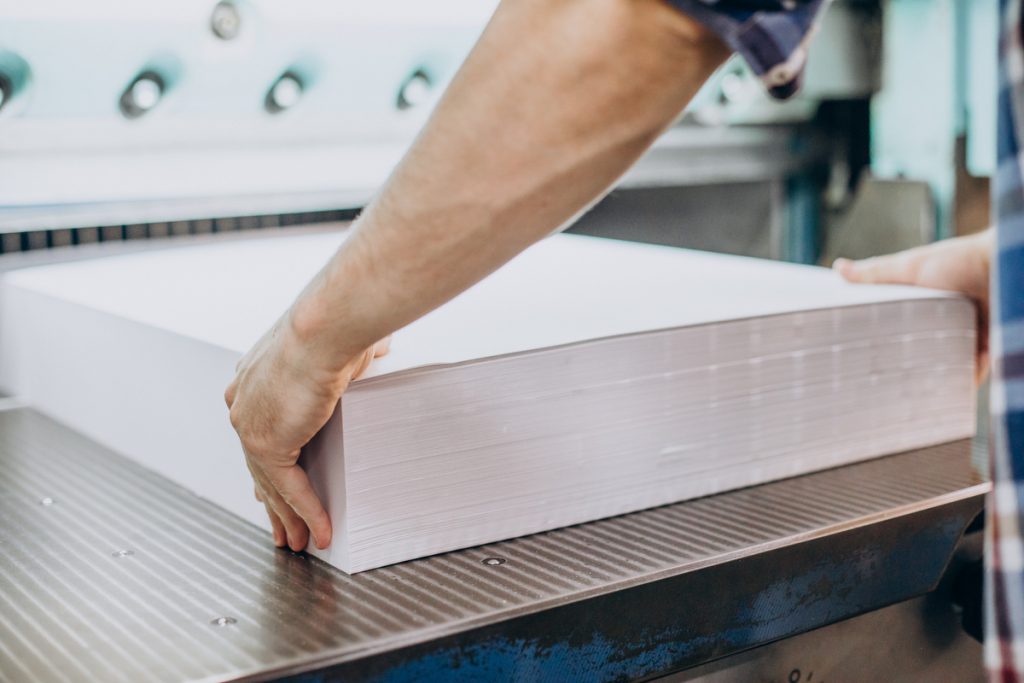Exploring Paper Stocks For Professional Printing

Introduction:
Professional Printing- Whether it’s producing business cards, brochures, flyers, or promotional materials, the quality and characteristics of the paper can significantly impact the final product’s visual appeal and overall impression. The exploration of paper stocks for professional printing is a critical endeavor that requires careful consideration of various factors, such as texture, weight, finish, and color.
Choosing the right paper stock involves understanding the specific requirements of the project and aligning them with the desired outcome. Different paper stocks offer distinct attributes that can enhance or detract from the intended message and design aesthetics. For instance, a glossy finish might be ideal for vibrant and high-resolution images, while a matte finish could lend a more sophisticated and elegant look to a document.
Thicker stocks are often associated with premium products, exuding a sense of professionalism and sturdiness. On the other hand, lighter-weight papers might be more suitable for cost-effective mass production, such as newsletters or event programs.
In this exploration of paper stocks for professional printing, we will delve into the various types, finishes, weights, and textures available in the market. We will examine their strengths, weaknesses, and best applications, providing valuable insights to guide individuals and businesses in making informed decisions for their printing projects. By understanding the intricate world of paper stocks, one can elevate the quality and impact of their printed materials, leaving a lasting impression on recipients and achieving their desired objectives.
What are the different paper finishes commonly used in professional printing?
In professional printing, various paper finishes are commonly used to achieve different visual effects and enhance the overall appeal of printed materials. One popular finish is glossy, which offers a smooth and shiny surface that reflects light, resulting in vibrant and eye-catching prints. Glossy finishes are ideal for projects that require high-resolution images, as they enhance color saturation and contrast, giving a polished and professional look. However, they are susceptible to fingerprints and may produce glare under certain lighting conditions.
On the other hand, matte finishes provide a non-reflective, smooth surface that exudes a sense of sophistication and elegance. They are well-suited for designs that prioritize readability and a subdued aesthetic. Matte finishes reduce glare and offer a softer appearance, making them a popular choice for brochures, business cards, and other marketing materials. Additionally, they are less prone to smudges and fingerprints, making them a practical option for items that require frequent handling.
Another commonly used paper finish is satin or silk. This finish falls between glossy and matte, offering a subtle sheen that strikes a balance between vibrant colors and reduced glare. Satin finishes provide a smooth texture and a soft touch, creating a luxurious feel. They are often chosen for projects that require a high-quality look with a touch of elegance, such as premium catalogs, magazines, and high-end brochures.

How does the selection of paper stock impact the perceived quality of printed materials?
The selection of paper stock has a profound impact on the perceived quality of printed materials. The type and quality of paper used can significantly influence how the final product is perceived by the viewer. When a high-quality paper stock is chosen, it communicates a sense of professionalism, attention to detail, and value. On the other hand, using a low-quality or inappropriate paper stock can undermine the overall impression of the printed materials.
The texture and finish of the paper stock play a crucial role in determining perceived quality. Smooth and refined textures, such as those found in coated papers, can convey a sense of elegance and sophistication. These papers tend to enhance the sharpness and clarity of printed images and text, contributing to a premium look and feel. In contrast, rough or grainy textures may give off a less polished impression, suitable for certain artistic or vintage aesthetics but potentially diminishing the overall perceived quality for other applications.
Heavier-weight papers are often associated with higher quality, as they provide a more substantial and durable feel. Thicker stocks can withstand handling and offer a sense of luxury and durability. In contrast, lighter-weight papers may be perceived as flimsy or less substantial, which can impact the perceived quality of the printed materials, particularly for items like business cards or marketing collateral.
What are the benefits of using textured paper stocks in professional printing?
Using textured paper stocks in professional printing offers several benefits that can enhance the overall appeal and impact of printed materials. Texture adds a tactile element to printed materials, engaging multiple senses and creating a unique and memorable experience for the recipient. One of the primary benefits is the ability to evoke a specific mood or aesthetic. Textured papers can range from subtle patterns to more pronounced embossing or raised surfaces, allowing for creative expression and customization. These textures can add depth, visual interest, and a sense of craftsmanship to printed materials, making them stand out from the crowd.
Textured paper stocks can enhance the perceived quality and value of printed materials. The presence of texture can give the impression of a premium and luxurious product, adding a sense of sophistication and elegance. When used strategically, textured papers can elevate the overall design and convey a message of professionalism and attention to detail.
Textured papers can help improve the readability of printed materials by minimizing glare and reducing fingerprints and smudges. The texture can provide a softer surface that makes text and images easier to view under different lighting conditions. This can be particularly useful for materials such as brochures, catalogs, and magazines that require clear legibility while maintaining a visually appealing presentation.

How can the weight of paper stock affect the cost and practicality of printing projects?
The weight of paper stock plays a crucial role in determining the cost and practicality of printing projects. The weight of paper refers to its thickness and density, typically measured in grams per square meter (gsm) or pounds (lb). Heavier-weight paper stocks are generally more expensive than lighter-weight options. The cost of paper is often a significant factor in printing projects, especially when producing materials in large quantities. Therefore, selecting the appropriate weight of paper stock is essential to balance cost considerations with the desired outcome.
The weight of paper stock also affects the practicality of printing projects in terms of handling, durability, and postal requirements. Heavier-weight papers are more rigid and sturdy, making them suitable for items like business cards, postcards, and product packaging. They provide a sense of quality and durability, enhancing the perceived value of the printed materials. In contrast, lighter-weight papers are more flexible and easier to fold, making them practical for items like brochures, flyers, and newsletters. Lighter-weight papers are also more cost-effective for mass production, as they consume less ink and may require less postage when mailing.
The weight of paper can impact the printing process itself. Thicker paper stocks may require adjustments to the printing equipment, such as adjusting pressure or ensuring compatibility with specific printers. Some printers have limitations on the maximum weight of paper they can handle. Therefore, it is crucial to consider the weight of the paper stock in relation to the capabilities of the printing equipment to ensure a smooth and successful printing process.
What are the considerations when choosing paper stocks for business cards?
When choosing paper stocks for business cards, several considerations should be taken into account to ensure that the cards effectively represent the brand and leave a positive impression on recipients. Firstly, the weight or thickness of the paper is crucial, as it reflects the quality and durability of the card. Thicker stocks, such as 14-point or 16-point cardstock, tend to feel more substantial and professional compared to thinner options.
Secondly, the finish of the paper plays a significant role in the overall look and feel of the business card. Matte finishes offer a smooth and elegant touch, while gloss finishes provide a shiny and vibrant appearance. The choice between matte and gloss largely depends on the desired aesthetic and the nature of the business. Additionally, special finishes like embossing, foil stamping, or spot UV coating can add a touch of luxury and make the card stand out.
The color and texture of the paper are also important factors to consider. White or off-white papers are common choices, but colored or textured stocks can create a unique and memorable impression. It is essential to select colors that align with the brand’s identity and convey the right message. Finally, environmental considerations have gained significance in recent years. Opting for eco-friendly paper stocks made from recycled materials or sustainable sources can demonstrate a commitment to sustainability and responsible business practices.

How does the choice of paper stock affect the readability of printed text?
The choice of paper stock has a significant impact on the readability of printed text. One of the key factors to consider is the paper’s opacity, which refers to its ability to prevent show-through or transparency. If the paper is too thin or lacks sufficient opacity, the text printed on one side may be visible from the other side, making the content difficult to read. It is important to select a paper stock with high opacity to ensure that the text remains clear and legible without any distractions.
Another consideration is the paper’s finish. Different finishes, such as matte or glossy, can affect how light reflects off the paper’s surface. Matte finishes tend to reduce glare and improve readability by minimizing reflections, making them a popular choice for printed text. On the other hand, glossy finishes can create glare and reflections that can interfere with the text, making it harder to read, especially under certain lighting conditions.
The color of the paper stock also plays a role in readability. While white or off-white papers are widely used and generally provide good contrast for black text, it’s important to consider the text color in relation to colored paper stocks. For instance, using light-colored text on a light-colored paper can diminish legibility. It is crucial to ensure sufficient contrast between the text and the paper background to ensure readability.
What are the eco-friendly options available in paper stocks for sustainable printing?
When it comes to eco-friendly options in paper stocks for sustainable printing, there are several choices available that can help reduce the environmental impact of printing. One option is to use recycled paper. Recycled paper is made from post-consumer waste, such as old newspapers, magazines, and office paper. By utilizing recycled paper stocks, you can help conserve natural resources and reduce the amount of waste sent to landfills. Look for papers that are labeled with high percentages of post-consumer waste content to ensure a higher level of sustainability.
Forest Stewardship Council (FSC) certification ensures that the paper comes from responsibly managed forests, where trees are replanted, biodiversity is protected, and local communities are respected. Additionally, papers certified by the Sustainable Forestry Initiative (SFI) and the Programme for the Endorsement of Forest Certification (PEFC) offer similar assurances of sustainable sourcing.
These papers are made from agricultural residues, such as wheat straw, sugarcane bagasse, or hemp fibers. Choosing tree-free options can help reduce deforestation and preserve valuable forest ecosystems.

How can the selection of the right paper stock enhance the branding and messaging of printed materials?
The selection of the right paper stock plays a crucial role in enhancing the branding and messaging of printed materials. First and foremost, the weight and thickness of the paper can communicate a sense of quality and professionalism. Thicker stocks convey a sense of durability and substance, which can reflect positively on the brand and its messaging. On the other hand, lighter-weight stocks may give a more casual or budget-oriented impression. Choosing a paper stock that aligns with the desired perception can reinforce the brand’s identity and make a strong first impression.
The finish of the paper is another important consideration. A matte finish can create an elegant and sophisticated look, ideal for conveying a professional and serious tone. It reduces glare and provides a smooth, tactile feel. In contrast, a glossy finish can deliver a vibrant and eye-catching appearance, making it suitable for designs that aim to grab attention and evoke excitement. The choice of finish should align with the brand’s personality and the intended message of the printed materials.
Techniques like embossing, debossing, foil stamping, or spot UV coating can add a touch of luxury, exclusivity, or emphasis to specific design elements or the brand’s logo. These enhancements can elevate the perceived value of the printed materials and reinforce the brand’s identity.
Color and texture also contribute to the branding and messaging. The color of the paper stock can be chosen to match the brand’s color palette or create a specific mood. Textured papers, such as linen or recycled paper, can add depth and visual interest, giving a unique and memorable touch to the printed materials.
Conclusion:
The careful selection of paper stocks based on factors such as texture, finish, weight, and color can make a significant difference in the visual appeal, durability, and overall impression of the final product.
By understanding the various types of paper finishes available, individuals and businesses can make informed decisions to enhance the desired message and design aesthetics. Whether opting for a sleek and glossy finish or a sophisticated matte look, the choice of paper stock can greatly influence the perceived quality and professionalism of the printed materials.
Considering the weight of paper stock is crucial, as it not only affects the cost but also plays a role in determining the durability and practicality of the final product. By selecting the appropriate weight, one can strike a balance between perceived quality and cost-effectiveness.





